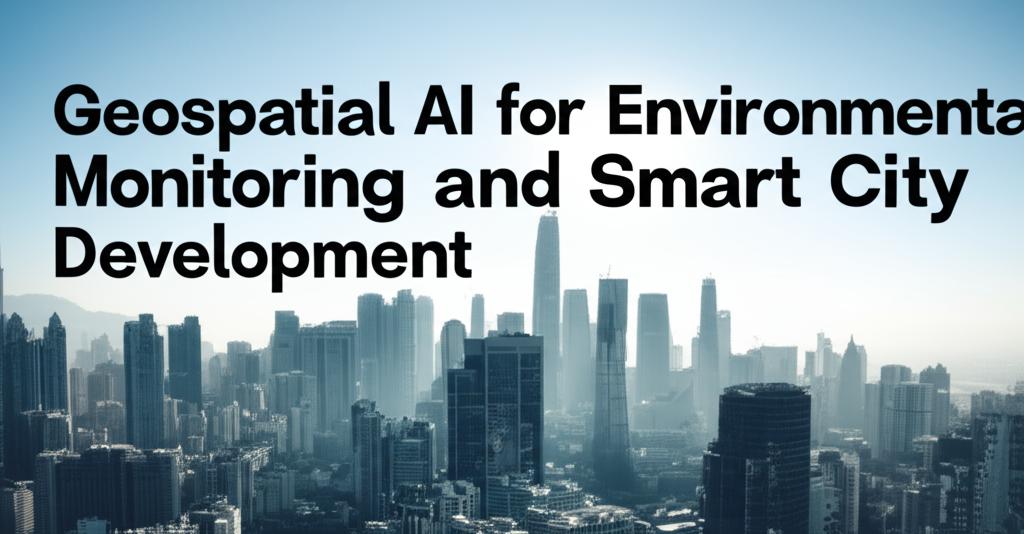Geospatial Artificial Intelligence (GeoAI) is rapidly transforming how we monitor our planet and develop smarter, more sustainable urban environments. By integrating the strengths of AI, particularly machine learning and deep learning, with geospatial data sourced from satellites, drones, and various sensors, GeoAI offers powerful capabilities for analysis, prediction, and real-time decision-making. This technology is no longer a futuristic concept but a present-day tool driving significant advancements across various sectors.
Environmental Monitoring: A Paradigm ShiftGeoAI is proving to be a game-changer in addressing pressing environmental challenges:
- Enhanced Monitoring of Natural Resources: AI algorithms analyze vast amounts of satellite imagery and sensor data to monitor land use changes, deforestation, water quality, and vegetation health with unprecedented accuracy and frequency. For example, NASA collaborates with Planet Labs and Google Earth Engine to improve climate policy, while the European Space Agency utilizes AI for forest management. These technologies enable the rapid identification of environmental threats like illegal logging or pollution hotspots, facilitating timely interventions.
- Climate Change Mitigation and Adaptation: AI-driven climate models improve weather forecasting and our understanding of climate change impacts. GeoAI helps in monitoring greenhouse gas emissions, assessing vulnerability to climate-related risks such as sea-level rise and extreme weather events, and identifying suitable locations for renewable energy infrastructure.
- Disaster Management and Response: GeoAI plays a crucial role in predicting, monitoring, and managing natural disasters like wildfires, floods, and droughts. Machine learning models analyze historical and real-time geospatial data to identify at-risk areas and enhance early warning systems. During and after disasters, GeoAI aids in damage assessment, resource allocation, and planning evacuation routes. For instance, AI can quickly analyze post-event satellite imagery to guide emergency response.
- Biodiversity Conservation: AI-powered tools assist in tracking wildlife populations, monitoring habitat changes, and detecting poaching activities. This data-driven approach helps conservationists make more informed decisions to protect endangered species and their ecosystems.
GeoAI is a foundational technology for creating smarter, more efficient, and sustainable cities:
- Urban Planning and Infrastructure Management: GeoAI enables planners to analyze urban dynamics, predict population growth, and optimize land use. It helps identify optimal locations for new infrastructure, public services like schools and hospitals, and green spaces. For instance, Sydney, Australia, uses AI to proactively identify and repair road defects, saving resources.
- Efficient Resource Management: Smart cities leverage GeoAI to optimize the use of resources like energy and water. AI algorithms can analyze real-time data from sensors embedded in city infrastructure to identify patterns in energy consumption and suggest measures for greater efficiency, thereby minimizing waste.
- Transportation and Mobility: GeoAI is revolutionizing urban transportation by analyzing traffic flow patterns, identifying congestion hotspots, and optimizing routes for public and private transport. This leads to reduced travel times, lower fuel consumption, and improved air quality. Some cities are using AI-powered GIS tools with real-time flood sensors to predict storm surges and road closures.
- Public Safety and Security: By visualizing complex data geographically, GeoAI enhances public safety. It can help law enforcement identify crime hotspots, predict potential hazards, and optimize emergency response strategies.
- Enhanced Public Services: Smart city initiatives worldwide are using GeoAI to improve a wide range of public services, from waste management optimization through intelligent collection routes to enhancing citizen engagement by analyzing service requests. Singapore, for example, has launched numerous AI tools to improve public services.
Several key technologies and trends are driving the advancements in GeoAI:
- Integration of High-Resolution Satellite Data: The increasing availability and resolution of satellite imagery from commercial providers are providing richer datasets for GeoAI applications.
- Machine Learning and Deep Learning: Algorithms like Convolutional Neural Networks (CNNs) and Recurrent Neural Networks (RNNs) are automating the analysis of complex geospatial data, from image classification to predictive modeling.
- Cloud Computing and Big Data Analytics: Cloud-based platforms provide the necessary computational power and storage for processing and analyzing the massive volumes of geospatial data generated.
- IoT Integration: The proliferation of Internet of Things (IoT) devices provides a constant stream of real-time data that, when combined with GeoAI, enables dynamic monitoring and response in smart city and environmental applications.
- Digital Twins: Creating virtual replicas of physical assets or even entire cities allows for simulation, analysis, and real-time monitoring of performance and environmental impacts.
The Geospatial AI market is experiencing substantial growth, with projections indicating a significant increase in market value in the coming years. Government investments in smart cities and national security, coupled with the increasing urgency of environmental challenges, are key drivers of this expansion. North America currently leads the market, with Europe focusing on environmental applications and Asia-Pacific experiencing rapid growth.
As GeoAI continues to evolve, it promises to unlock even more sophisticated capabilities. The integration of advanced AI techniques will lead to more accurate predictions, greater automation, and more intuitive ways to interact with and understand our complex world. This will empower decision-makers across various sectors to build more resilient environments and truly intelligent cities for a sustainable future.

